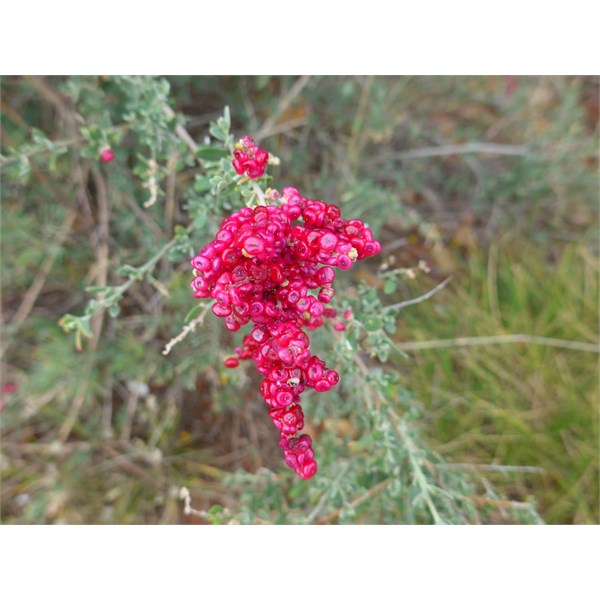What plant is this?
Submitted: Monday, Sep 10, 2018 at 20:23
ThreadID:
137228
Views:
3510
Replies:
4
FollowUps:
3
This Thread has been Archived
Member - J&A&KK
Hi All
The photo of the plant was taken on 5 July 2016 close to the
Ochre Pits on Namatjira Drive, West MacDonnel Ranges. I have done a few web searches but have failed to find anything that looks like this.
The plant was a loner. No other similar plants found within a 200m radius. That years was quite wet in the Red Centre. The flowers look more like fruit. No ants or insects were on it as I thought they should be.

Red Berry Plant
I look forward to your informed comments.
Cheers
John
Reply By: Member - Stephen L (Clare SA) - Monday, Sep 10, 2018 at 22:38
Monday, Sep 10, 2018 at 22:38
Hi
John
It is Ruby Saltbush and it is good bush tucker.
The fruit starts off small and green, and as it starts to matures, goes from yellow to a real ruby red colour. It is when the fruit is at its darkest, it is the time to pick and eat them.
Yes the fruit is safe to eat and is quite sweet.
And for the record, I have eaten them personally many times.
Cheers
Stephen
AnswerID:
621138
Follow Up By: Member - Stephen L (Clare SA) - Monday, Sep 10, 2018 at 22:50
Monday, Sep 10, 2018 at 22:50
Hi
John again
I should have also mentioned, go to the "Wildflower" section and type in "Ruby Saltbush"
If you plant looks like the photos that I added a few years ago, then your plant is safe to eat.
Just make sure that a
Dingo or dog had not cocked it's leg on the bush......lol
Cheers
Stephen
FollowupID:
893671
Follow Up By: Member - J&A&KK - Tuesday, Sep 11, 2018 at 10:04
Tuesday, Sep 11, 2018 at 10:04
Hi Stephen
Many thanks for the information. Initially I thought it was saltbush but decided it was not after looking at the photos in the wildflower section.
What “threw” me was the large size of the bunch of berries on the bush I photographed vs the sparse distribution of the berries on the ruby saltbush photos in the wildflower section. I also failed to take any photos of the plant as a whole so subsequent identification was compromised.
I will add my photo to those in the wildflower section.
Cheers
John
FollowupID:
893672
Reply By: GerryG - Thursday, Sep 20, 2018 at 19:57
Thursday, Sep 20, 2018 at 19:57
It's not Ruby Salt Bush (Enchylaena tomentosa). The fruit on Ruby Salt bush is evenly distributed throughout the plant and are not clustered on the ends of branches as shown in the photo. The plant can have green, yellow,
orange and red berrys at the same time. It is a secondary food source like lollies. Aboriginals would walk past a bush and with open fingers and sieve the red ripe fruits into their hand. They are sweet, have round succulent leaves and grow through out
the desert regions of Australia. Eat the flesh and spit the reasonably large seed out as they can leave a bitter taste in your mouth. (The seed)
The plant in question appears to be of the Rhagodia genus, maybe "spinescens" species. (Spiny saltbush). They have all the berrys clustered at the end of certain branches as shown and are all the same colour at any one time. There are three species of Rhagodia found in Centralia Australia and are only found in Australia. The only reference of Aboriginal use I have found, is the
young girls rubbing the berries in their hair to make it red. I don't believe the berrys are edible.
Just my two bobs worth!
AnswerID:
621311